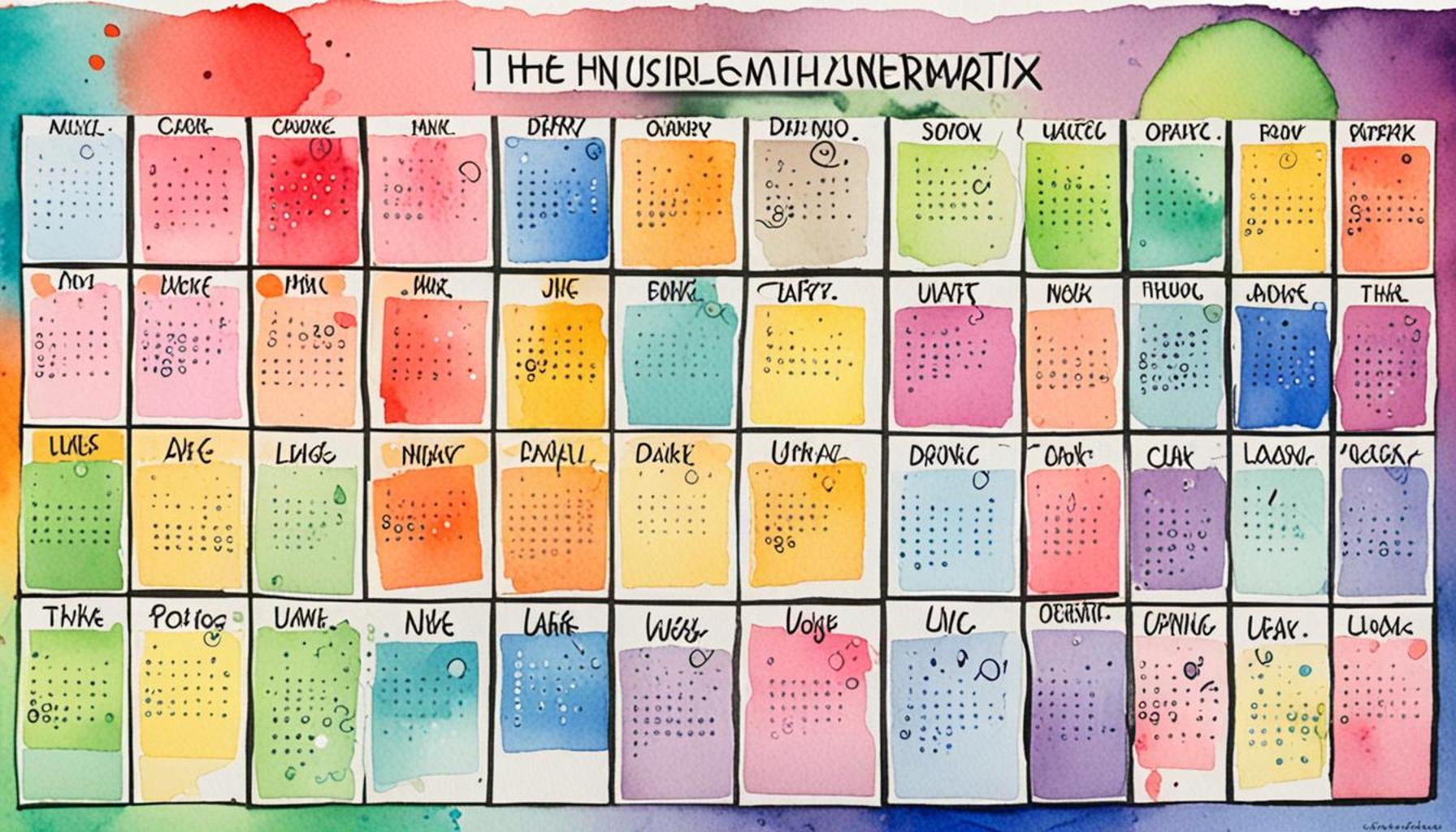Master Task Management with the Eisenhower Matrix Prioritize Effectively

Unlocking Your Productivity Potential
In an era where our attention is constantly pulled in various directions—be it through endless notifications, social media alerts, or even intrusions in our physical workspace—mastering task management has become essential for anyone looking to enhance their productivity. The Eisenhower Matrix acts as a valuable framework that empowers individuals to prioritize tasks with precision, enabling a greater focus on what truly matters in both their personal and professional lives.
The Four Quadrants
- Urgent and Important: These are the tasks that require immediate action. They might include meeting deadlines, handling urgent client requests, or addressing crises. An example can be a project that is due tomorrow, necessitating focused work right away.
- Important but Not Urgent: These tasks are significant for long-term growth and should be scheduled rather than rushed. They often involve planning, such as setting goals, developing skills, or engaging in self-care. For instance, making time each week for professional development workshops can lead to significant gains in your career over time.
- Urgent but Not Important: While these tasks need immediate attention, they can be delegated to others. Perhaps someone requests a report you’ve prepared for a meeting, but another team member can easily step in to present it. Recognizing these distractions can free you to focus on more impactful activities.
- Not Urgent and Not Important: Tasks in this quadrant can often clutter our to-do lists without providing real value. Examples might include excessive social media browsing or attending unproductive meetings. By minimizing or entirely eliminating these tasks, you create space for more essential endeavors.
Leveraging the Eisenhower Matrix can yield transformative benefits in managing daily activities. By categorizing tasks according to urgency and importance, you can:
- Reduce overwhelm and stress: Understanding which tasks truly deserve your attention can simplify decision-making and diminish anxiety about looming deadlines.
- Enhance productivity through better focus: Concentrating on priority tasks leads to improved efficiency and effectiveness, as you are working on what matters most.
- Align tasks with your long-term goals: Scheduling tasks that contribute towards greater objectives ensures that daily actions resonate with your aspirations.
As you delve deeper into this methodology, it becomes vital to evaluate how frequently you may fall into the trap of busywork or get caught up in unproductive activities. The Eisenhower Matrix encourages a strategic shift in mindset—leading you to accomplish more with less effort. Think of it as a roadmap through the chaos of daily life, guiding you toward activities that yield the greatest rewards. It’s a skill worth mastering, especially in our fast-paced world.
In conclusion, the impact of effective task management cannot be overstated. By actively engaging with the Eisenhower Matrix, individuals in the United States and beyond can reclaim their time and channel their energies towards meaningful productivity, ultimately paving the way for personal fulfillment and professional success.
CHECK OUT: Click here to explore more

Understanding the Power of Prioritization
At the core of the Eisenhower Matrix is the fundamental principle of prioritization. In a world teeming with distractions, distinguishing between what matters and what doesn’t is crucial for effective task management. By categorizing tasks into four distinct quadrants based on their urgency and importance, this technique allows individuals to make informed decisions that can lead to enhanced productivity and focus.
The first quadrant, Urgent and Important, represents the tasks that need immediate attention and directly contribute to your goals. These tasks often feel the most pressing—think of finalizing a presentation due for a board meeting tomorrow or addressing an urgent client complaint. However, frequent engagement in this quadrant can lead to a reactive work culture where you are continuously firefighting rather than strategically planning. It is essential to manage your time here wisely and try to limit the frequency of urgent matters by organizing and prioritizing effectively beforehand.
Strategies for Successful Navigation
To excel at navigating the Eisenhower Matrix, consider the following strategies that can help you to make the most of each quadrant:
- Set Clear Goals: Establishing specific, measurable, achievable, relevant, and time-bound (SMART) goals can enhance your ability to understand which tasks are genuinely important. This clarity helps in accurately placing tasks within the right quadrant.
- Evaluate Regularly: Taking the time to review your tasks frequently allows you to identify shifts in priority. For instance, a task that was once categorized as Important but Not Urgent may need to be elevated to Urgent and Important if deadlines loom closer.
- Limit New Commitments: Assessing your existing responsibilities before taking on additional projects can help control your workload. Adopting the mindset of saying “no” or deferring tasks that do not fit your priorities can significantly improve your focus.
- Utilize Technology: Leverage productivity tools and applications designed to streamline your task management. Many apps incorporate features of the Eisenhower Matrix, allowing you to categorize, track, and prioritize tasks in a user-friendly manner.
The second quadrant, Important but Not Urgent, often holds the key to long-term success. Engaging with these tasks can lead to significant professional development and personal growth. Examples include strategic planning sessions, skill-building activities, or regular health check-ups. While these may not require immediate action, scheduling time to address them can avert crises and promote a sustainable balance in your life.
Confronting the Urgent but Not Important tasks can be tricky, as they demand your attention yet do not add substantial value to your goals. Identifying these distractions is vital; whether it’s responding to non-essential emails or attending unnecessary meetings, minimizing their impact can increase your effectiveness.
Meanwhile, the quadrant of Not Urgent and Not Important can be a black hole of procrastination. It is crucial to remain vigilant and identify activities that drain your energy without contributing positively to your goals. When you streamline your to-do list by either eliminating these tasks or significantly reducing their frequency, you can redirect that time and energy toward activities that matter.
Master Task Management with the Eisenhower Matrix: Prioritize Effectively
Task management can often feel overwhelming, with multiple responsibilities vying for your attention. However, utilizing the Eisenhower Matrix can revolutionize your approach to prioritization. By categorizing tasks into four distinct quadrants—urgent and important, important but not urgent, urgent but not important, and neither—individuals can achieve clarity and enhance productivity.
The Eisenhower Matrix encourages users to focus on what truly matters. This systematic method not only aids in decision-making but also prevents burnout caused by endless to-do lists. By distinguishing tasks based on urgency and significance, you’re equipped to tackle high-impact activities that drive results.
| Category | Benefits |
|---|---|
| Time Management | Enhances your ability to allocate time effectively, reducing procrastination and improving focus. |
| Stress Reduction | Minimizes the pressure of unfinished tasks by promoting a clear set of priorities. |
Adopting the Eisenhower Matrix leads to improved task clarity, fostering a proactive mindset. As users engage with this framework, they can identify tasks that are often mismanaged, allowing for a healthier work-life balance. Embrace the Eisenhower Matrix in your task management strategy to transform chaos into order and achieve your goals more effectively.
CHECK OUT: Click here to explore more
Unlocking Efficiency with the Eisenhower Matrix
The power of the Eisenhower Matrix lies not just in task identification but also in the profound impact it can have on your overall efficiency. By categorizing responsibilities appropriately, you cultivate an environment focused on productivity rather than busyness. It’s essential to adopt a strategic mindset that recognizes how the thoughtful application of the matrix can transform your daily workflow.
Navigating the Quadrants with Precision
Let’s delve deeper into how you can effectively maneuver through each quadrant with purpose:
- Urgent and Important: While tasks in this category call for immediate action, one must also consider the larger context. A well-timed delegation can prevent tasks from overwhelming you. If feasible, enlist help or redistribute tasks among your team to foster a collaborative atmosphere. For example, if preparing for a presentation is urgent and crucial, consider sharing sections of the work with colleagues to lighten your load while encouraging team involvement.
- Important but Not Urgent: This quadrant is the goldmine for cultivating a proactive approach. Engaging with these tasks can yield long-lasting benefits, both professionally and personally. Schedule regular intervals to focus on your long-term vision—whether it’s dedicating an hour each week to professional development or ensuring time for family gatherings. Tools like Google Calendar or Asana can effectively remind you to prioritize these essential tasks before they escalate into urgent matters.
- Urgent but Not Important: The key to addressing tasks that fall into this category is to limit their interference with your core goals. Consider automating responses to common inquiries or designate a specific time in your day dedicated to handling these tasks, thereby reducing their tendency to disrupt your focus on more important initiatives. For example, set aside a 30-minute window each afternoon to tackle non-critical emails, allowing you to address them without compromising your key objectives.
- Not Urgent and Not Important: This quadrant offers a critical opportunity for self-reflection and reassessment. Engaging in activities that consume time without value can lead to burnout and dissatisfaction. Make it a habit to conduct a weekly review of your activities, asking yourself, “Is this benefitting my larger goals?” Identifying activities that merely serve as distractions, such as scrolling through social media or binge-watching shows, can lead you to replace them with productive alternatives that align with your priorities.
Furthermore, embracing a mindset of continuous improvement can elevate your task management approach. By staying informed through resources like productivity podcasts, blogs, or even workshops focused on time management techniques, you can stay on top of emerging strategies and tools that enhance your execution of the Eisenhower Matrix.
Data from various studies reveal that individuals who utilize prioritization frameworks like the Eisenhower Matrix are often more satisfied with their professional progress. According to a survey conducted by the American Psychological Association, 62% of respondents reported feeling less stressed after implementing a structured task management system. These statistics emphasize the importance of not just adopting the matrix but continuously refining your approach.
Ultimately, mastering task management with the Eisenhower Matrix is an evolving journey, influenced by personal preferences, workplace dynamics, and your unique goals. As you integrate these strategies into your daily routine, you may find that not only does your productivity increase, but so does your sense of achievement and fulfillment.
CHECK OUT: Click here to explore more
Embracing Productivity with the Eisenhower Matrix
In a world where time is often our most precious asset, mastering task management using the Eisenhower Matrix can be a transformative experience. By effectively prioritizing tasks across its four quadrants, individuals not only reclaim their time but also channel their energy towards activities that genuinely matter. Recognizing the difference between what is urgent and what is truly important can reduce stress levels and enhance overall productivity.
The journey of integrating the Eisenhower Matrix into your daily routine is not merely about checking items off a to-do list; it’s about cultivating a mindset of strategic thinking and reflection. As you regularly assess and adjust your tasks, you will find that this framework encourages a more profound focus on long-term goals while managing the immediate demands of life. Additionally, the evidence supporting the effectiveness of prioritization frameworks reinforces the notion that a structured approach can lead to greater job satisfaction and personal fulfillment.
Ultimately, the power of the Eisenhower Matrix transcends mere task management. It invites individuals to engage in a transformative process that aligns daily actions with their deeper aspirations and values. By incorporating this method into your life, you will be better equipped to navigate the complexities of modern demands while maintaining a clear vision of what truly matters. Take the first step toward enhanced productivity—explore the Eisenhower Matrix and transform how you approach your tasks today.



